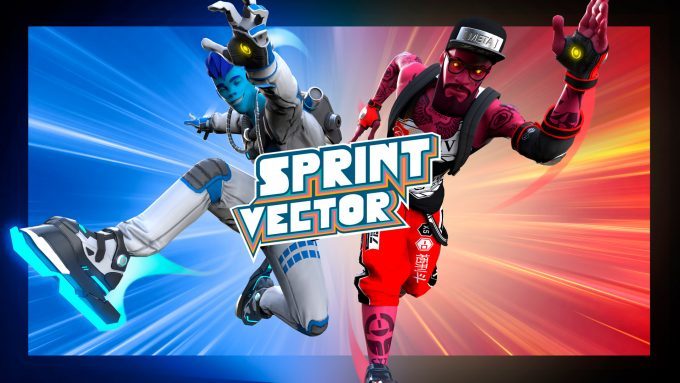“Adrenaline platformer” is the apt descriptor that Survios is using for their newly announced title, Sprint Vector. The core of the game is what the company is calling the Fluid Locomotion System, a synthesis of VR movement techniques seen elsewhere that together add up to a supremely satisfying way to move around VR worlds at high speed without getting dizzy.
Moving players through virtual spaces is presently one of VR’s biggest challenges. Basic first-person locomotion—the foundation upon which a major part of the last two decades of game design has been built—makes many users nauseous when applied to VR. The industry has been researching and uncovering new techniques to move players across large virtual spaces in a ways that are comfortable. Some of the popular methods are putting players in cockpits (largely applicable to vehicle games), blinking/teleporting (where players click where they want to go and instantly appear there), or no virtual locomotion at all (designing the game to not require any virtual movement).
Except for the cockpit method (which doesn’t work thematically with non-vehicle games), few VR locomotion methods discovered so far allow players to move quickly and immersively across large distances.
Enter Sprint Vector’s new approach to VR locomotion which has players literally racing through virtual environments by means of direct interaction with the game world. At first glance it’s the sort of virtual movement that VR veterans would suspect would lead to instant nausea. And while it’s too early to say if it will work for every VR player (as nausea can be triggered differently from one player to the next), my hands-on time with the Fluid Locomotion System in Sprint Vector has astounded me. It didn’t only let me race through virtual space with no nausea, it was also incredibly fun.
So how does it work? At its core, the Fluid Locomotion System works by the player pulling a trigger on their controller and then swinging their arm backward as they release the trigger. This propels the player forward with a bit of momentum. Your other arm does the same thing, and using both in a swinging or running motion gets you into a continuous cycle of propulsion that lets you ‘skate’ through the world. Doing so quickly makes you move even faster. Vibrations in the controllers help you feel how much each swing of your arm is contributing to your momentum, which lets you quickly realize if your form is good or needs adjusting.
And while skating or running in this way is the primary method of movement, it gets seamlessly blended with jumping, flying, climbing, and swerving.
To jump you use another button on the controller to pull and release which gives you a little boost upward, moreso if you time it just right. You can double jump too, by doing the same with the other controller while already in the air.
Once you’re in the air, you can also have brief moments of flight. You control your flight by pointing both hands out in front of you like Superman, aiming your direction based on where you point your hands.
Climbing works by grabbing onto special hand-holds on walls and then using the controller to fling yourself upward.
Then there’s swerving, which uses a variety of inputs from your head and hands to let you quickly juke side to side, which comes in especially handy for dodging obstacles that would otherwise slow you down.
It’s clear why Survios is calling this the Fluid Locomotion System; all of these different forms of movement work together cohesively in Sprint Vector to add up to a thrilling race through the virtual world. As a player you feel deeply in control of how you’re speeding through the level, with your ability to weave each skill together determining how quickly you can complete each the stage.
Another reason the Fluid Locomotion System is compelling is because it keeps you immersed. Up to now, immersion and movement in VR have largely been a tradeoff. Blinking lets players move across large spaces, but over millions of years our brains have evolved a spatial sense that relies partly upon seeing the world move around us to map our surroundings; constant teleportation in VR is an immersion killer because it doesn’t let you map the virtual world in the same way that you do the real world. The Fluid Locomotion System, on the other hand, lets you see the world as you move through it, and asks you to directly interact with it at every move, further reinforcing the realism of the virtual world around you.
The significance of Sprint Vector and the Fluid Locomotion System should not be underestimated. Doom (1993) didn’t invent the mechanics of the first-person shooter, but it wrapped up the locomotion and control learnings of prior works into a functional and compelling package that inspired widespread adoption of the game itself and an entire genre to come after it. I think Sprint Vector has a good shot at doing the same.
– – — – –
As for Sprint Vector itself, Survios insists that it’s still very early days for the game, and say they still have lots of improvements and refinements they want to make to the Fluid Locomotion System. So far they aren’t committing the game to any particular VR platforms (though it was demonstrated at GDC on the HTC Vive, so that’s a pretty good bet), and (sadly) aren’t ready to talk about a launch date yet.



